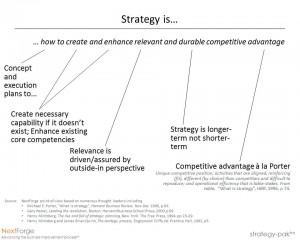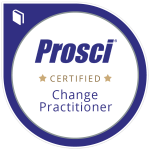Everyone knows what strategy is. Just ask them. The difficultly we typically encounter is no one group, dare we say no two individuals, share the same definition.

Director, Institute for Strategy and Competitiveness
Harvard Business School
This is the issue we have faced over and over again. With our clients, we could expend literally days of team time discussing the “s” word. While this can be interesting and potentially important, it is not efficient. Also, when working with other consultants for example, we have found quite a bit of variation in the use of the word “strategic”. Often, we believe, to raise the importance of the matter at hand, the work I/my department/my team have to do. Instead of getting scattered like those constructing the Tower of Babel, we have, over the years, found having a rigorously developed working definition of strategy helpful. Starting with Porter’s seminal work “What is strategy?” and the collective body-of-work by strategic thought-leaders Gary Hamel, Henry Mintzberg, James Brian Quinn, et al, our working definition has been pressure tested by scores of leadership teams.
A consensus?
If you will suspend your possible doubt about a “better” definition of strategy for a few minutes, let us walk you through our thinking, and maybe it will save you a number of man-weeks in leadership team meetings to reach your working definition of strategy.
Strategy is…
… how to create and enhance relevant and durable competitive advantage
Let us breakdown the definition and explain some of our word choices.
“…how to…”
Strategy is not only the concepts, the big thoughts and the mental frameworks. It is also the plans to execute.
“…create and enhance…”
If we need certain capabilities to deliver on our strategy and if the capability does not exist, we create or build it. If we currently possess the needed capability, we are looking to constantly enhance or improve it.
“…relevant…”
Looking from the outside in, how is it relevant or important to our customer?
“…and durable…”
Strategies are long-term by nature, not easily reproduced. They must be durable or sustainable.
[As a side note, this is the one word we have changed from our original working definition. We updated our word choice to better align with Warren Buffet’s relatively recent popularization of “durable” in lieu of “sustainable” within the common strategic vernacular.]
“…competitive advantage”
This may be the principal point of difference among leadership team members- focusing on competitive strategy or how-we-go-to-market. Often leaders throughout the organization hang a “strategy” moniker on important tasks and activities. We reserve the “s” word to those elements of our business, of our business model, causing our customers to prefer and select our product/service bundle over our competitors’ offerings.
How can this help you?
Often we begin leadership working sessions with a pre-meeting homework assignment. Before the first meeting on the topic of strategy, have your team read Porter’s “What is strategy?” Have some discussion about what they read and how it relates to your organization. Throw a slide up with a working definition of strategy and see if you don’t get quick buy-in to the definition. Now you can rapidly move on to the important and urgent work of leadership- setting direction.
This is the second post in a definitional series on the key elements of strategy. We will also include a few observations along the way on how we have, or might, advance the more traditional concepts. Collectively, we refer to the grouping of strategic concepts as the strategy-paksm.
Professor Porter’s picture is from his Twitter account @MichaelEPorter.







